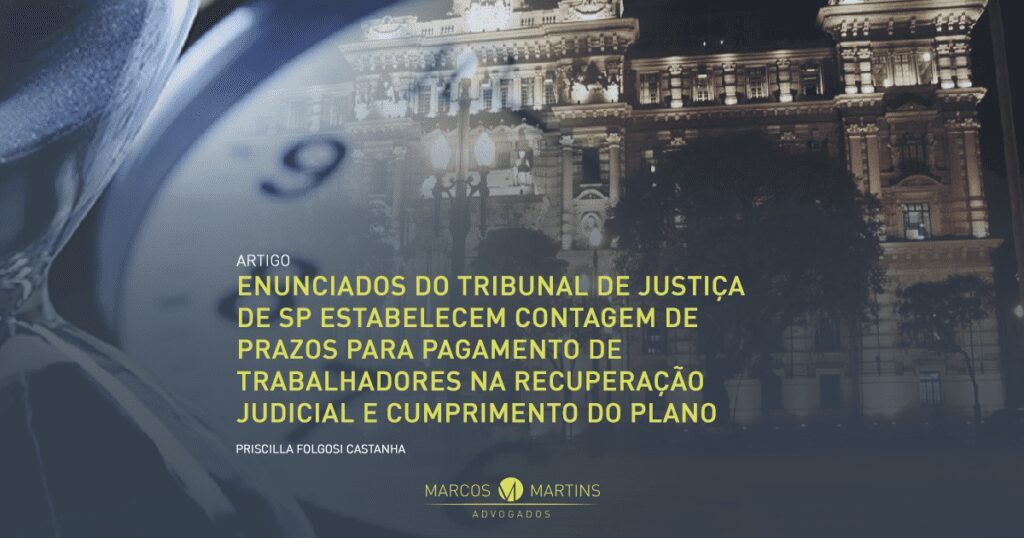Priscilla Folgosi Castanha
Lawyer at Marcos Martins Advogados
The Group of Chambers Reserved for Business Law of the São Paulo Court of Justice unanimously approved two statements on deadlines in judicial reorganization. The statements were published in the Diário de Justiça on January 17, 2019.
Statement I establishes the initial term for counting the one-year deadline for payment of labor creditors:
- The one-year period for the payment of labor and occupational accident creditors, referred to in article 54, caput, of Law 11.101/2005, is counted from the ratification of the judicial reorganization plan or the end of the suspension period referred to in article 6, paragraph 4, of Law 11.101/2005, regardless of extension, whichever occurs first.
Statement II defines the initial term for counting the period in which the reorganized company will remain under judicial supervision, a period in which the judicial administrator monitors the correct fulfillment of the obligations set out in the reorganization plan “The two-year period of judicial supervision, provided for in article 61, caput, of Law 11.101/2005, begins after the expiry of the grace period established”.
The establishment of the judicial supervision period was already established by doctrine and case law and reflects the reality of reorganization plans, since most of them establish a grace period for creditors to start being paid, and it would be unreasonable for the supervision period to run from the date the reorganization was granted and end before payments to creditors began.
In this way, companies will remain in judicial reorganization for at least two years after payment of unsecured creditors begins, thus allowing the trustee and the judiciary to supervise effective compliance with the reorganization plan.
Enunciation I, on the other hand, promises to be the subject of much discussion, since doctrine and case law differ on the matter, as a result of the law’s omission. Even the two Business Law chambers of the Court had conflicting views before the unification of the theses and, in the words justifying the Statement, Judge Paulo Roberto Grava noted that they opted to adopt the most beneficial term for the worker.
Article 54 of Law 11.101/2015 – LRJ, states that “The judicial reorganization plan may not provide for a period of more than one (1) year for the payment of credits derived from labor legislation or arising from occupational accidents due up to the date of the request for judicial reorganization”, however, it does not establish the initial term for counting this period. For some scholars, such as Marcelo Papaléo de Souza[1], the period would begin to run from the date of the filing of the petition for judicial reorganization, based on the most beneficial criterion for workers, as well as the legislation that regulated the old concordata, article 175 of which established that the deadline for compliance was counted from the date of filing. Another current argues that the deadline would begin with the approval of the reorganization plan[2].
Despite the praiseworthy intention of unifying the thesis and protecting workers, taking into account the unexceptional slowness in starting to pay labor creditors, which led the TJSP to issue such a pronouncement, it is believed that imposing a rule not provided for in the legislation governing the procedure could lead to risks to the systemic harmony of judicial reorganization processing and uncertainty in the event of bankruptcy being decreed, since there would be the possibility of labor creditors being paid even before the plan is approved by the creditors’ meeting, and worse, without even being sure that it will be approved.
The possibility of paying the labor creditors before the general meeting could also generate a lack of interest on the part of the workers in attending the meetings and even approving the plan, undermining one of the basic principles of judicial reorganization, which is parity between the creditors.
It is also argued that if the plan is not approved and bankruptcy is declared, labor creditors would not suffer the limitation set out in article 83, I, of the LRF, which limits payment in the event of bankruptcy to 150 minimum wages per labor creditor. In other words, the workers who were paid before the plan was rejected would end up benefiting to the detriment of the other creditors of the bankrupt estate, mitigating the isonomy between creditors.
Despite the controversy, the 2nd Bankruptcy and Concordat Court of the District of São Paulo has, ex officio, ordered companies to adjust their plans under the terms of Statement I. When asked to express its opinion in an interlocutory appeal, the 1st Chamber of Business Law of the São Paulo State Court of Justice argued that:
- Although it is possible for the approval of the plan to occur after the 180-day period of suspension of individual actions and executions, provided for in art. 6, §4, of the LREF, this Law was concerned with establishing a swift procedure and set the stay period precisely to give breath to companies in crisis, generating an environment that would favor negotiation with creditors. The idea, therefore, is that approval should still take place within 180 days of the reorganization being granted.
- Given these dynamics, it is easy to see that it would be absolutely contrary to the spirit of Law 11.101/05 if, one year after the end of the stay period, the judicial reorganization plan had not even been approved.
- Even if this were to happen, the fact is that whatever initial term is set, including the date of the plan’s approval, there will always be a risk that the labor creditors will be paid and then there will be some modification or even bankruptcy. The ceiling of 150 minimum wages applicable to bankruptcy is only for labor claims that have not yet been paid. It doesn’t matter if the creditors were satisfied beforehand and then the plan was rejected, or if afterwards, with the plan already ratified, some cause for conversion into bankruptcy arose.
- As for the alleged incentive for labor creditors to stop attending the General Meeting of Creditors, it is not clear how this could contribute to the worsening of the company’s crisis situation or to the rejection of the plan, given that any claims that may have been satisfied will no longer have to be included in the general framework.
- Consequently, the alleged violation does not prosper” (TJSP; Interlocutory Appeal 2031138-87.2019.8.26.0000; Rapporteur: Judge Hamid Bdine; 1st Chamber Reserved for Business Law of the São Paulo State Court of Justice)
The truth is that the Statement is very recent and the discussion about its application and validity has not yet reached the Superior Court of Justice, which is responsible for standardizing the interpretation of federal legislation, preventing different understandings between the states of the Federation.
It is possible to identify that the failure of the Executive and Legislative Branches to discuss the various bills to reform the Judicial Reorganization and Bankruptcy Law that are going through the houses, opens up space for the so-called judicial activism, which tries with the tools available to make up for omissions and distortions in the current law, often transferring the burden of the slow process to companies in crisis and looking for the shortest routes to much deeper and more deep-rooted problems, such as the lack of material structure and human resources faced by the Judiciary.
[1] SOUZA, Marcelo Papaleo de. A nova lei de recuperação e falência e as consequências no direito e no processo do trabalho. São Paulo: RT, 2006. p.177.
[2] SZTAJN, Rachel. Comentários à Lei de recuperação de empresas e falência. 2. Ed. São Paulo: RT, 2005. p. 267.








